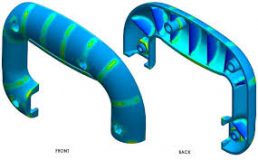If you work in the world of injection molding, you know that sink marks can be a real pain in the… well, you know. Sink marks occur when the surface of a molded part sinks or shrinks due to uneven cooling. But fear not! There are ways to prevent sink marks and keep your parts looking their best.
In this blog post, we’ll dive into the world of sink mark injection molding and share some tips on how to avoid these pesky imperfections. From adjusting your cooling time to using the right materials, we’ll cover everything you need to know to prevent sink marks from ruining your next project. So sit back, relax, and let’s get witty about preventing sink marks.
Understanding Sink Mark Injection Molding:
The injection molding process is widely used for manufacturing plastic parts. However, one common issue that arises during injection molding is sink marks. Sink marks are visible depressions on the surface of a part caused by uneven cooling of the material. It is essential to understand the causes and mechanisms behind this phenomenon to prevent it from occurring. By incorporating preventive measures and adjusting the design of both the mold and part, we can minimize the occurrence of sink marks in injection molding production.
Definition of Sink Mark Injection Molding:
When injection molding, sink marks can appear on the surface of the finished product. These marks are depressions or indentations, caused by uneven cooling of the plastic material during the molding process. Sink marks can affect both the appearance and functionality of a part, making it important to prevent them.
Manufacturers can minimize sink marks by adjusting mold design and material selection, as well as processing parameters such as packing pressure and time. By understanding sink marks and implementing prevention strategies, manufacturers can ensure high-quality injection-molded parts that meet customer needs.
Causes of Sink Mark Injection Molding:
Uneven cooling is the root cause of sink marks in injection molding. Thick areas of the part take longer to cool, causing the surface to sink or become depressed. In addition, high injection pressure or temperature can also lead to sink marks. While it may be tempting to reduce cooling times, this approach can actually worsen the problem by causing warpage and distortion.
Instead, design changes such as adding ribs or fillets can help prevent sink marks. Proper mold design and process control are also critical to minimizing sink marks in injection molding. By taking a holistic approach that addresses all potential causes, manufacturers can achieve consistent and high-quality results.
Click Here to Read Part 2nd
How to Prevent:
Injection molding is a highly efficient manufacturing process that produces high-quality, complex parts. However, sink marks can be a common challenge during the injection molding process. These depressions on the surface of the molded part can impact both functionality and aesthetics, which is why prevention measures are crucial. One way to prevent sink marks is by adjusting injection parameters such as speed and pressure.
By reducing injection pressure or slowing down the injection speed, manufacturers can minimize uneven cooling and reduce the likelihood of sink marks. Another method is by adding ribs or gussets to the design to provide additional support and prevent sink marks. Increasing wall thickness in areas where sink marks are likely to form or using filler materials can also help strengthen the plastic material and reduce the occurrence of sink marks.
Preventive Measures for Sink Mark Reduction:
When it comes to reducing sink marks in injection molding, preventive measures are key. Modifying the design of the part to reduce thick sections and improve flow can help prevent uneven cooling that causes sink marks. Additionally, adjusting injection molding parameters such as cooling time, packing pressure, and melt temperature can reduce sink marks.
Utilizing techniques such as gas-assisted injection molding can also help minimize sink marks. Proper mold maintenance and cleaning are other important factors that cannot be overlooked when it comes to reducing defects caused by sink marks. By taking these preventive measures seriously, manufacturers can significantly decrease the likelihood of sink marks forming in injection-molded parts.
Adjusting the Packing Pressure and Time:
Sink marks can be a significant challenge in injection molding, causing parts to appear flawed or unsightly. However, there are certain methods that can help prevent them. One such method is adjusting the packing pressure and time during the injection molding process.
By doing so, you can ensure that the plastic fills the mold cavity evenly, preventing sink marks from forming due to uneven cooling or filling. Packing pressure refers to the force applied to the plastic in the mold cavity while packing time is the duration for which this pressure is maintained. Proper optimization of these parameters can lead to high-quality molded parts with minimal sink marks.
 Plastic Injection Mold Material Guide – Advantages & Applications Of 20 Common Injection Molding Materials
Plastic Injection Mold Material Guide – Advantages & Applications Of 20 Common Injection Molding Materials  10 Plastic Injection Processes – Advantages, Disadvantages, And Applications Of Plastic Injection
10 Plastic Injection Processes – Advantages, Disadvantages, And Applications Of Plastic Injection  The three key factors affecting mold cost have nothing to do with materials!
The three key factors affecting mold cost have nothing to do with materials!  How to Prevent Sink Mark Injection Molding – Part 2
How to Prevent Sink Mark Injection Molding – Part 2